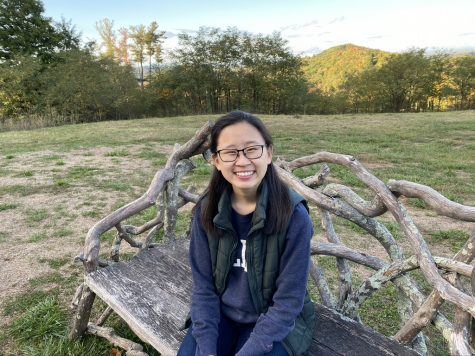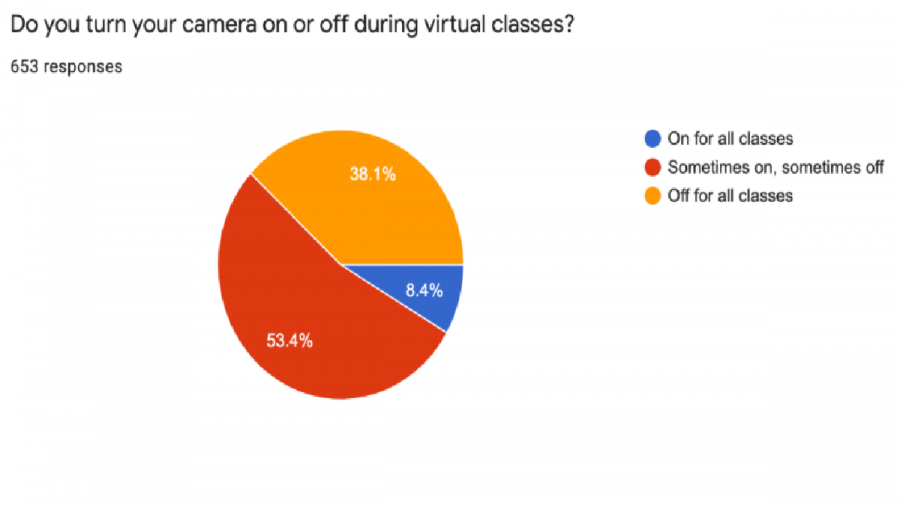Please, Turn Your Camera On: I’m tired of the black grid.
Trying to speak in front of twenty black rectangles on a Zoom meeting might be one of the most exhausting things I’ve done for school, narrowly behind running the mile for gym at 8:30 AM and answering 12 multiple choice questions in the last three minutes of an English midterm. When quarantine first started, I thought I’d conserve energy by sitting like an immobile pebble at my desk, doing everything I couldn’t do in person through my computer with an infinite supply of Goldfish at my side.
I didn’t realize how much more I’d lose simply by not seeing the faces of other human beings, whether it was in person or on my laptop screen. But more importantly, I didn’t realize how powerful of a decision it was to click that “Camera on” button for every class, club, or meeting. It’s a powerful courtesy that not enough people, not enough students, show.
The choice is always a painfully conscious one. One simple click holds a myriad of considerations: How many other people have them on? How do I look today? How do I feel? And in a handful of cases, the considerations extend deeper.
Some people have no choice but to keep their cameras off for their safety, for any mental health concerns, or because they have to attend to other responsibilities while in school. There are very real, very reasonable justifications out there for keeping cameras off, which is why it’s such a relief that it hasn’t been made mandatory by the school.
Dr. Torrey Trust, an associate professor of learning technology at the University of Massachusetts Amherst, said it best in the New York Times: “By requiring them to turn on their video, that’s almost like you walking into their home and teaching without their permission.” She says educators should find other ways to engage with students, whether it be through chat or audio only.
But this isn’t the free pass for everyone to shut their cameras off and call it a day.
Just the opposite. This is a call to the majority of us, who are in positions to do so, to turn the camera on—even if it’s just for a few minutes at the start or end of class.
Because we’ve been missing a voice from the equation of considerations. Teachers—who wake up at just the same time as we do, who might feel as self-conscious as we do, who soak in the painfully quiet Zoom room as we do—still have to find ways to run each class with seemingly unfailing energy.
This is a significant determinant for the few students who choose to show their faces on camera. Of the students who said they turn their cameras “On for all classes” in a school-wide poll, nearly every single respondent who elaborated mentioned showing “respect” to the teacher and letting them know that they were there, among other personal reasons such as focusing and staying engaged.
So this brings us to the remaining majority who choose to keep their cameras off, in most instances. Without going into the realm of more severe, unavoidable circumstances… most of it seems to come down to peer pressure, doesn’t it?
It seems the first week of school did a lot to set some unspoken precedents into place. Classes that had more people with cameras on have stayed that way, while classes with less have slowly dwindled, leaving fewer people’s faces (often none) visible. There’s an achingly understandable reasoning to this trend; if no one else has their camera on, who’d want to be the lone soul drowned in an ocean of (literal) darkness?
As someone who has to guide classroom-sized club meetings every week, I can tell you that each visible face matters. Even if it seems insignificant, or unnoticeable, or embarrassingly arrogant in a way to be the only one, I can reassure that it truly isn’t. The way I see it, each visible face a visual anchor to quickly glance at and reaffirm: “Oh good, I’m not just talking to the void.”
All of this is to say that the “Camera on” button holds an undervalued deal of power. And if most of us are honest with ourselves, we are in positions (privileged enough) to wield that power if we choose. It’s worth flicking that button on, even just before the teacher starts sharing their screen or to give a small wave.
At this point in the year, it might seem like we’re glued to the stance we’ve taken for the first semester—after all, what will people think if you suddenly start showing your face after months of your dolphin profile picture having established its place? But I assure you, it’s never too late to extend this bit of kindness to teachers, club leaders, and other classmates.

(she/her/hers)
Anna Ryu is the Editor-in-Chief of The Shaker Bison. As a senior, this is her fourth year participating in Shaker’s school newspaper....



Brianna Niemi • Feb 26, 2021 at 8:34 am
I sometimes have my camera on, and my dad told me that I have to turn on my camera, and I am doing so much better in school.
Eric Randall • Feb 23, 2021 at 7:09 pm
Hi Anna. I am Shaker grad, former editor of the Bison (sophomore, junior & senior years), former USA Today reporter and now Editor in Chief for the NYS School
Boards Association (North Colonie is a member). Your well-written commentary gives a perspective on an issue many if not all schools are experiencing, and I would like to reprint it in our newspaper, which goes to 11,000 school leaders (principals, superintendents and school board members) statewide. Sound okay?
Kylie Moore • Feb 17, 2021 at 2:11 pm
I throughly enjoyed your take on this issue. Some of the reasons people didn’t turn their cameras on didn’t cross my mind. I was aware that some people have valid reasons for not turning their cameras on. Like have to babysit or other household chores and responsibilities. But peer pressure and how you being the only one with your camera on can make you feel a bit self conscious. I hadn’t thought of it like that before. Great article! Thanks:)